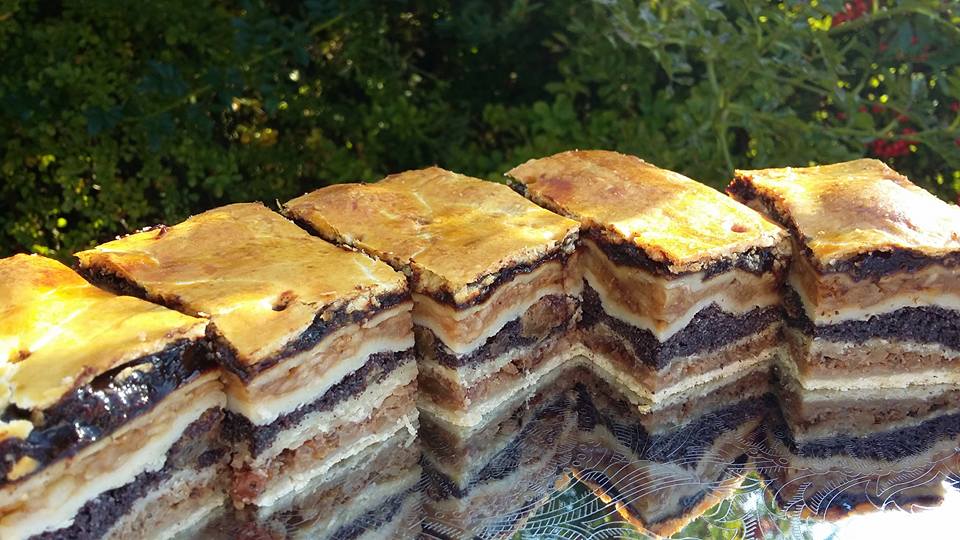Recipe of the week: flódni
Flódni can be considered a staple dish when it comes to Jewish gastronomy. It is undoubtedly the most well-known and loved in Hungary. Its preparation requires a great deal of meticulousness, but the result is well worth the wait.
The history of flódni
According to foodandwine.hu, flódni is “the queen of Purim desserts”. Purim is a Jewish celebration – the ‘Jewish Mardis Gras’, as The Independent calls it -, in the centre of which stands a woman called Esther and the fact that the Jewish population managed to survive a Persian king’s attempts to wipe them out about 2500 years ago.
The name ‘flódni’ most probably comes from the German version, ‘Fladen’, though it is important to note that
the German word refers to a broad, flat and thin piece of cookie, unlike the Hungarian word that is attached to a tall piece of cake that has several layers.
Interestingly, the first flódni mentioned describes the dish as having a cheese filling, suggesting that the walnut and plum jam fillings are a new addition and that the flódni that we know today is actually pretty young, 200 years at most. However, by now, it has definitely become a staple food and a popular dessert option for Jewish celebrations.
2012: world record set in Hungary
Flódni has a special place in Hungarian culture, partly because of Ráchel Raj. In 2012, she managed to win the title of ‘World’s Largest Flódni’ with her creation. The attempt at the record-breaking took place at the Sziget Festival, of all places.
For the event at the 20th Sziget Festival, Raj and her team used over 500 kilogrammes of ingredients.
Luckily, it was all worth it, and the team won the title with the dessert that was over 20 meters long.

Photo: facebook.com/Rachelsflodni
The team of 8 worked on the challenge for a total of 100 hours. The number of flódni they made, if placed on top of each other, could have reached 96 meters, the height of the Parliament.
Recipe
First of all, do not be daunted by the length of the recipe. It has several stages, but a lot of the time you just have to cool the ingredients. It may seem like a lot of work but it actually takes about 2 hours (one hour each day, since the fillings have to be done the previous day) and you will definitely be pleased with the results.

Photo: facebook.com/BevaltReceptek
Ingredients for the pastry
500 g flour
200 g butter
75 g icing sugar
2 egg yolks
some salt
130 g white wine
Ingredients for the fillings
It is best to prepare all the fillings the day before and cool them until the pastry is ready.
Walnut filling
200 g ground walnuts
50 g raisins cut up
180 g sugar
100 g water
Poppy seed filling
175 g ground poppy seed
70 g sugar
90 g water
some orange zest
Plum jam for the jam filling
occasionally, apricot jam is used
Apple filling
1 kg apples, peeled and cut up into thin slices
1 tbsp honey
1 tbsp sugar
1 tbsp cinnamon
5 pieces of cloves
150 ml white wine
some bread crumbs – about 1 tbsp, to soak up the extra liquids
For the top
1 egg yolk
2 tbsp milk
Preparation

Photo: facebook.com/flodni – Beatrix Gilpert
Mix the flour, the icing sugar, the butter, the egg yolks together and add the salt as well. Slowly add in the white wine until you get a smooth pastry batter. Divide this batter into 4 equal sections and roll them out to fit the 26.5×19.5 cm oven tin. Place them on pieces of baking paper and let them cool in the fridge overnight.
For the walnut filling, heat the ingredients on the stove until the sugar has melted and the mixture has become nice and thick. Let it cool in the fridge overnight.
For the poppy seed filling, heat the ingredients on the stove for about 2-3 minutes, until you notice bubbles. This mixture also has to go into the fridge for a night.
For the apple filling, steam the apples together with the honey, the sugar, the white wine, the cloves and the cinnamon. It is important not to overcook it. When it is done, put it in a sieve and let the extra liquid slowly leave the mixture.
Line the tin and place one of the pastry sheets inside. Add the walnut mixture, then put another piece of pastry on top. Spread the poppy seed filling on top, then add another piece of pastry. Add the apples and spread the plum jam on top. Add the last piece of pastry, brush it with the mixture of egg yolk and milk and place it in the fridge for about 10 minutes so that it sets.
Preheat the oven for 200 C, cook the dessert like that for 10 minutes, then reduce the heat to 175 C and cook for another 50 minutes. When done, let it cool for at least an hour outside of the oven.
It is a good idea to let the whole batch cool overnight so that it properly sets.
After all this work, your delicious dessert is done, enjoy!
If you crave more desserts, check out this article about the 5 best confectionaries in Budapest.
Featured image: facebook.com/kemencepek
Source: foodandwine.hu, indepenent.co.uk, fuszereslelek.nlcafe.hu, budaorsiinfo.hu






Hi
Can I use canola oil instead of butter?
If yes, what are the quantities?
Thx
Micha
Hi Micha,
You can try swapping the butter to canola oil, although that will probably change the taste and the consistency somewhat, so be mindful about that.
Here’s a helpful conversion chart:
https://canolaeatwell.com/ask-judy-canola-oil-and-baking/
And this may also be helpful:
https://www.leaf.tv/articles/how-to-substitute-canola-oil-for-butter/
Have fun baking and lest us know how it went 🙂
how many servings does this recipe make up?